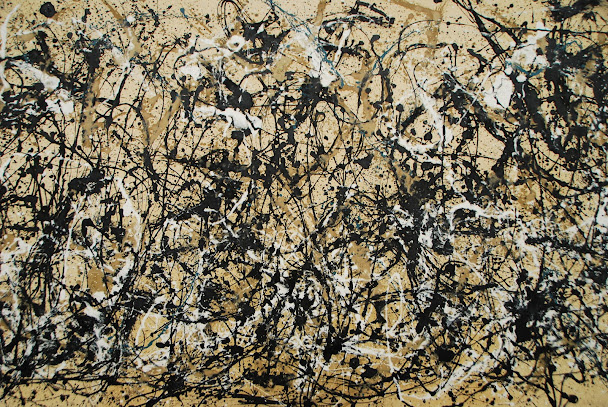There were many different art styles emerged during the mid modern era, and Abstract Expressionism was clearly one of them. Abstract Expressionism developed in the context of diverse overlapping sources and inspirations. The crisis of World War II and its aftermath are the key to understanding the concerns of the Abstract Expressionists. Many young artists, troubled by man's dark side and anxiously aware of human irrationality and vulnerability, wanted to express their concerns in a new art of meaning and substance.
Jackson Pollock,
Autumn Rhythm (Number 30), 1950
Jackson Pollock,
Mural, 1943
Jackson Pollock
Abstract Expressionist painter Jackson Pollock was one of the leading figures addressing issues of angst and anxiety, which were prevalent in the post-World War II era. His famous painting, "Autumn Rhythm (Number 30)," was created in his studio—a small barn behind his house in East Hampton. This period marked a high point in modern art, as artists began to move away from representing nature, which had been central to art-making for centuries. Pollock was interested in creating purely abstract forms. He used house paint, allowing it to seep into and stain the canvas rather than merely applying it to the surface. His work includes splashes that resemble dots and others that evoke the feeling of a night sky.
Another magnificent piece by Pollock is the "Mural." He painted this while working as a janitor and handyman at the Museum of Non-Objective Art. It was during this time that Peggy Guggenheim recognized his talent and introduced him to the art patron who would later champion his career. In this work, Pollock employed his signature drip technique, placing the canvas flat on the studio floor while flicking paint in what appeared to be a haphazard manner. However, the drips always flowed downward, suggesting that the canvas was initially standing upright. He regarded this painting as a moment of liberation, pushing beyond the restrictive traditions of easel painting.
Mark Rothko,
No. 210/No. 211 (Orange), 1960
Mark Rothko,
No. 3/No.13, 1949
Mark Rothko
Another significant abstract expressionist painter from the mid-modern era was Mark Rothko. Rothko created the famous painting No. 210/No. 211 (Orange) in 1960, influenced by the postwar period when society faced fundamental questions, particularly in the aftermath of the Holocaust and the introduction of atomic weaponry. He contemplated how one could connect with the spiritual in our modern age. The painting features essentially two colors—orange and dark purple—but each of these colors contains infinite variations. There are numerous shades of yellows and oranges within those spaces, and the purple acts both as a space that the orange can occupy and also as a kind of frame. The result is a seemingly endless set of variations.
Another remarkable masterpiece by Rothko is No. 3/No. 13 (Magenta, Black, Green on Orange) from 1949. This work follows a compositional structure that Rothko explored for 23 years. It features narrowly separated, rectangular blocks of color that hover in a column against a colored background. The edges tend to fade and blur; the colors are never entirely flat. The slight unevenness in their intensity, along with the layering of washes, creates ambiguity, shifting between solidity and intangible depth. Through his work, Rothko clearly expresses basic human emotions such as tragedy, ecstasy, and doom.
Helen Frankenthaler,
The Bay, 1963
Helen Frankenthaler,
Mountains and Sea, 1952
Helen Frankenthaler
Inspired by Jackson Pollock, another notable abstract expressionist painter who emerged during the mid-modern era was Helen Frankenthaler. When she painted "The Bay" in 1963, she was already a well-regarded artist. This painting was selected as one of the works for the American pavilion at the 1966 Venice Biennale. Frankenthaler's approach involved a soak-stain method using diluted acrylic paint. This technique provided her with more flexibility in viscosity and movement than oils, allowing her greater control as she poured the thinned paint onto the taut, unprimed canvas, where it would become absorbed into the fabric's weave.
Another remarkable painting by Frankenthaler is "Mountains and Sea," created in 1952. This work exemplifies the staining process, in which an artist pours thinned paint onto raw, unprimed canvas. The result is fields of transparent color that appear to float in space, with the canvas weave establishing the image's flatness. Frankenthaler's art emerged in the aftermath of World War II, which prompted a significant shift in American social consciousness toward abstraction.
For a long time, I didn’t truly appreciate abstract paintings until this moment. It helped me realize how to search for the emotions I was looking for when gazing at these artworks. If given the opportunity, I would love to own "Mural" by Jackson Pollock. I adore the colors and shapes incorporated into that painting; somehow, it speaks to me in a deeply emotional way.
Biography
Mountains and Sea, Frankenthaler, www.nga.gov/audio-video/audio/collection-highlights-east-building-english/mountains-and-sea-frankenthaler.html. Accessed 18 Nov. 2024.
Paul, Stella. “Abstract Expressionism: Essay: The Metropolitan Museum of Art: Heilbrunn Timeline of Art History.” The Met’s Heilbrunn Timeline of Art History, 1 Oct. 2004, https://www.metmuseum.org/toah/hd/abex/hd_abex.htm
Rothko, Mark. “No.3/No.13 (Magenta, Black, Green on Orange), 1949 - Mark Rothko.” Www.Wikiart.Org, 1 Jan. 1970, https://www.wikiart.org/en/mark-rothko/no-3-no-13










I absolutely love Pollock, he is one of my favorite artists. His pieces are full of raw emotion and just being. They take my breath away following the different colliding drips. Rothko's works make me feel like I am staring through a window to the unknown, to an uneasy future that will bring forth a lot of change. I think he beautifully captured those emotions of post-war emotions. Frankenthaler's works are beautiful and the inspiration from Pollock shines through. I love her stain method, it makes for dreamy art that you could float away into.
ReplyDelete